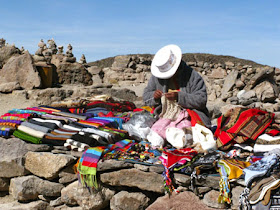The annual migration of nearly 2 million wildebeest, zebras
and gazelles through
Tanzania and
Kenya is a spectacle unlike any other.
Called one of the "Seven New Wonders of the World," this event highlights movement of immense proportions for wildlife in Africa.
 |
| The plains are literally covered with migrating wildlife. |
A few summers ago Larry and I witnessed
the Great Migration in early August as the animals journeyed from
Tanzania into Kenya. The migration is reversed during the winter. Wildlife follows
a predictable route, but
the exact
timing varies each year, depending on the start and severity of the dry season
throughout eastern Africa.
Wildebeests and zebras typically spend
December
to April in Tanzania, nursing new calves born in the spring. The
slow-moving calves draw the attention of lions, cheetahs and hyenas, and this
mix of predator and prey offers prime wildlife-viewing opportunities in nature
preserves like Serengeti National Park and the Ngorongoro Conservation Area
home of the greatest concentration of mammalian predators in the world.
 |
| Wildebeests make up the majority of migrating wildlife. |
Seasonal rains usually end in
May. Grass and leaves begin wither, and to maintain their constant
foraging, grazing species are forced to move west and then north in search of
food. This is the start of the Great Migration, a steady stream of animals in
columns that can stretch for many miles, heading toward the western and
northern Serengeti.
Predators -- more territorial than migratory -- await the zebra and wildebeest
as these animals pass through their hunting grounds. The migrating herds must
cross the Grumeti River, where crocodiles will feast on the weak and the slow.
Scavenging birds watch from treetops and circle overhead.
June and July are typically the best
months for witnessing the Great Migration in the western and northern Serengeti
of Tanzania.
 |
Zebras follow the wildebeests, further chomping down
grass that has been left as the wildebeests moved on. |
As the summer progresses, the herds travel farther north.
Between July and August, they cross the
Mara River, where some are lost in
surging floodwaters and others are seized by waiting crocs. They move into
Kenya, typically reaching the abundant greenery of the
Masai Mara in
August or September, a dazzling number
of animals within a single nature preserve.
Some naturalists claim that the Masai Mara contains the largest concentration
of predators along the migratory route which makes it especially dangerous for
the oldest and youngest of the species. We witnessed several examples of “the
nature of things” during our visit. The animals stay there until October or November.
 |
Not all of the wildebeests make it across the Mara
River; crocodiles are waiting for any that may falter. |
Most safaris visit the area before fall brings another rainy
season to the plains, and the herds turn south toward Tanzania. The animals
that complete the journey will have traveled more than 1,800 miles, covering
Africa's vast grasslands in a clockwise direction. Watching huge clouds of wildlife
on the move, attempting to stay alive by finding new feeding grounds and evading
predators, is truly a unique experience worth planning your Africa visit
around.
Photos by Larry and Beverly Burmeier



















































